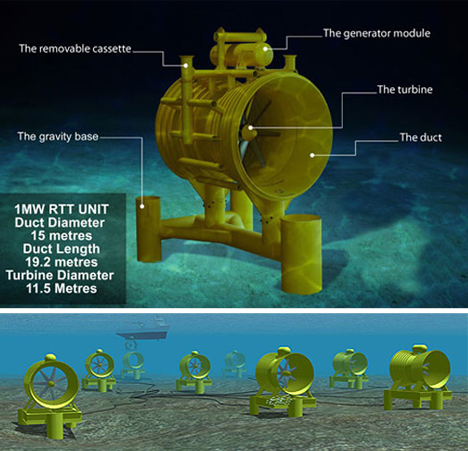Poo and Tidal Power – 6th Entry into the Wild Energy Challenge – Please Cast Your Vote
 This is an entry into the Adult section of Wild Energy. If you like this entry please give it a rating out of five stars (see the bottom of this page).
This is an entry into the Adult section of Wild Energy. If you like this entry please give it a rating out of five stars (see the bottom of this page).
My name is Scott Covit and I am currently a second year law student at Suffolk University Law School where my studies concentrate on Energy and Environmental Law. I am a reader of inhabitat.com and saw the competition and thought that I would write up an example of a solution for the problem of the proposed Hydroelectric facility in New Zealand.
This entry was meant to take some of the leading ideas and solutions to sustainable energy design that I have either read about, learned about, or heard about and bring them together. In no way are the specific solutions I speak of a concept of my own, but rather, I am using the ideas of these technologies to discuss and analyze a sustainable solution that the competition calls for. The images I attach, as well, are not my own images, and were taken through a google images search in order to produce a visualization of the concepts I am discussing. Thank you.
Sincerely,
Scott Covit
The PooPower image was taken from http://www.physorg.com/news118589790.html
The Tidal Power image was taken from http://webecoist.com/2008/11/09/hydroelectric-wave-tidal-power/11-underwater-tidal-power-station/
The Mokihinui River (“the River”) must invest in a diverse array of sustainable energy designs that coincide with what is available in geographic locality. So here are a couple of conceptual ideas that include designs from other sustainable solutions and have been implemented as a renewable energy source:
Poo Power
Although most people think poop is gross (and yeah, there is a point to that) it is a low-impact, low-cost sustainable energy source. Places like the UK are using poop from all animals (chickens, cows, dogs, and even humans) to power their homes, buildings, parks, farms or whatever else they fancy. For
example, the $4 million project at Didcot, UK1 will use 200 homes in a closed cycle system to produce poo power. Using anaerobic bacteria over a three week treatment course, waste is transformed and purified into usable methane and without the smell usually associated with this type of waste. This can be used to directly heat a home or used to generate electricity. Either way, everyone poops (or so that book says) and can be utilized in bathrooms all along the River to distribute a unique sustainable design that can power. Likewise, farming areas that contain domesticated animals and animals for food also poop and therefore can contribute to poo power that would not only save people’s energy bills and create an efficient sustainable energy design, but also save the environment from methane that is twenty times more potent against the atmosphere than CO2.
Tidal Power
Since part of the River empties out into the ocean, tidal power is an available option. Tidal Stream Generators use the motion of the waves to move a turbine that then powers the generator that creates the electricity. This method is particularly low cost and has a low ecological impact. Tidal energy
should only be utilized in areas that have a consistent source of wave currents. In areas like the Channel Islands, up to 3GW could be produced and distributed through power grids. There is also the solution by Aquamarine Power2 that produces electricity by placing an “Oyster” at the bottom of the sea and the motion of the tides generate the energy. I don’t know exactly what the environmental impact on aquatic life would be with the introduction of this technology, but it is a good alternative energy source that can harness the energy of moving water on all of our coasts. Just three of these things can provide 2.5MW directly to an on-shore generator and a farm of 20 is capable of powering 12,000 homes. There is also the possibility of using off-shore wind farms in wind rich areas or off-shore solar arrays that stand out in the middle of the ocean and distribute power to the coastal areas. The point is that coastal areas that have an abundance of sustainable energy resources and are a great locale to start diversifying the grid on the Mokihinui River. Whatever cost of these solutions, they will certainly be smaller in comparison to Mokihinui Hydro’s estimated cost of over $300 million and they will have a less ecological and environmental impact of the surrounding areas in New Zealand.
1 http://www.greenoptimistic.com/2010/10/08/didcot-human-waste-biogas/
2 http://www.aquamarinepower.com/
loading...
loading...
Tags: green energy design



Voices of our community